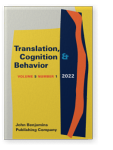Vol. 5:1 (2022) ► pp.50–83
Working memory tasks in interpreting studies
A meta-analysis
Studies about working memory (WM) and interpreting have used a variety of methods and results are often conflicting. There is therefore the need to analyse the cognitive tasks which have been used so far to assess their effectiveness in detecting WM performance differences. This paper presents the findings of a meta-analysis that compares the results of interpreters and interpreting students (study group) to the results of non-interpreters (control group) in four cognitive tasks (reading span, n-back task, listening span and dual tasks). Interpreters show a significant WM advantage of medium size over non-interpreters in tasks based on verbal stimuli, but not in tasks based on non-verbal stimuli. In addition, differences are larger when there is a wider gap in interpreting expertise between the two groups.
Article outline
- 1.Introduction
- 2.Background and motivation
- 3.Methods
- 3.1Literature search and selection criteria
- 3.2Task classification
- 3.3Groups: Interpreters, interpreting students and non-interpreters
- 3.4Variables
- 3.5Statistical methods
- 4.Results
- 4.1Reading span task
- 4.1.1Reading span accuracy: Comparison between interpreters and non-interpreters
- 4.1.2Reading span accuracy: Comparison between interpreting students and non-interpreters
- 4.1.3Reading span accuracy: Comparison between interpreters and interpreting students
- 4.2N-back task
- 4.2.1N-back task accuracy: Comparison between interpreting students and non-interpreters
- 4.2.2N-back task RT: Comparison between interpreting students and non-interpreters
- 4.3Listening span task
- 4.3.1Listening span accuracy: Comparison between interpreters and non-interpreters
- 4.3.2Listening span accuracy: Comparison between interpreting students and non-interpreters
- 4.4Dual tasks
- 4.4.1Dual tasks accuracy: Comparison between interpreters and non-interpreters
- 4.4.2Dual tasks accuracy: Comparison between interpreting students and non-interpreters
- 4.5Analyses on all WM tasks
- 4.1Reading span task
- 5.Discussion
- 6.Conclusion
- Acknowledgements
-
References
